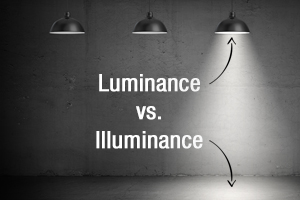Luminance vs. Illuminance
In the lighting world, many lighting terms often sound similar but have vastly different meanings. This can lead to confusion and a misunderstanding of lighting terminology overall. In fact, two of the most used terms, illuminance and luminance are examples of words most often incorrectly interchanged.
What is the difference between “luminance” and “illuminance”?
Luminance
Luminance describes the measurement of the amount of light emitting, passing through or reflected from a surface from a solid angle. It also indicates how much luminous intensity can be perceived by the human eye. This means that luminance indicates the brightness of light emitted or reflected off a surface. In the display industry, luminance is used to quantify the brightness of displays.
There are a variety of units used for luminance. The International System of Units, (SI) unit for luminance is candela/square meter (cd/m2). In the U.S. one of the most common units of measure is the foot-lambert (fL); 1 foot-lambert (fL) equals 3.426 cd/m2. Professionals in the industry will be familiar with the term nit (nt). Nit is a non SI term used for luminance, and 1 nit is equivalent to 1 cd/m2.
Luminance is measured using instruments such as Konica Minolta Sensing’s LS-150 or LS-160 Luminance Meter or CS-150,CS-160 or CS-200 Luminance and Color Meters.
Illuminance
Illuminance is a term that describes the measurement of the amount of light falling onto (illuminating) and spreading over a given surface area. Illuminance also correlates with how humans perceive the brightness of an illuminated area. As a result, most people use the terms illuminance and brightness interchangeably which leads to confusion, as brightness can also be used to describe luminance. To clarify the difference, illuminance refers to intensity of light falling onto a surface, while brightness refers to the visual perceptions and physiological sensations of light. Brightness is not a term used for quantitative purposes at all.
The SI unit for illuminance is lux (lx). In the U.S. people sometimes use the non-SI term foot-candle when referencing illuminance. The term “foot-candle” means “the illuminance on a surface by a candela source one foot away”. One foot-candle is equivalent to one lumen per square foot which is approximately 10.764 lux.
Illuminance (lux) is measured using instruments such as Konica Minolta Sensing’s T-10A or T-10MA Illuminance (lux) meter, CL-200A Chroma Meter, CL-70F CRI Illuminance meter or a CL-500A illuminance spectrophotometer.











